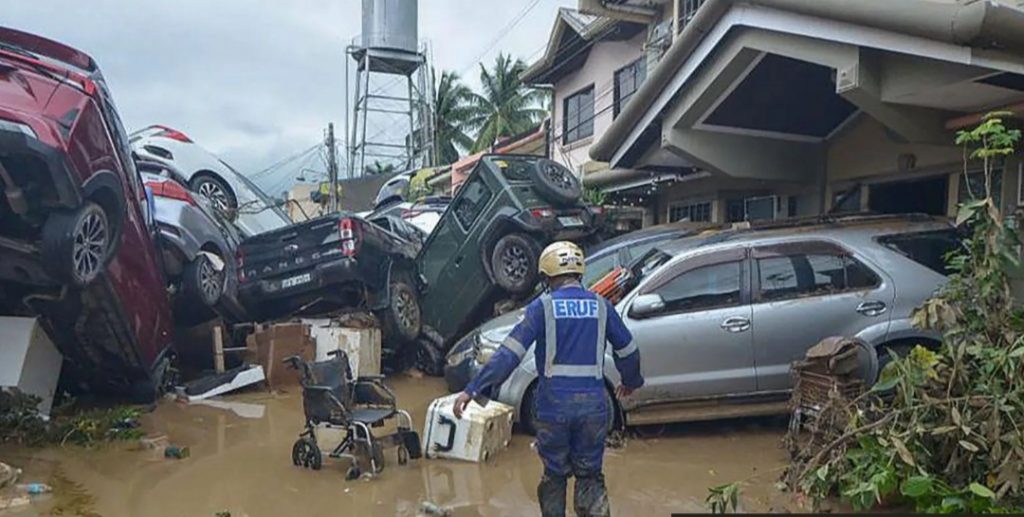
Esther Imonmion
At least 66 people have been killed and hundreds of thousands forced to flee their homes after Typhoon Kalmaegi, one of the strongest storms to hit the Philippines this year, ripped through the central region on Tuesday, 4 November 2025, authorities said on Wednesday.
Typhoon Kalmaegi, locally known as Tino, flooded entire towns on the densely populated central island of Cebu, where 49 of the fatalities were recorded. Another 26 people remain missing, according to the Office of Civil Defence.
Videos circulating on social media showed residents stranded on rooftops while cars and shipping containers were swept through city streets as Typhoon Kalmaegi unleashed torrential rains and destructive winds.
Among the dead were six crew members of a military helicopter that crashed on Mindanao island on Tuesday. The aircraft had been deployed to assist in relief operations for victims of Typhoon Kalmaegi when it went down near Agusan del Sur.
“Communication with the helicopter was lost, which immediately prompted a search and rescue operation,” the Philippine Air Force said. A spokeswoman later confirmed that six bodies believed to be those of the pilot and crew had been recovered.
Although Typhoon Kalmaegi has weakened since making landfall early Tuesday, it continues to bring winds of up to 130 km/h (80 mph) as it moves westward across the Visayas region toward the South China Sea.
The National Disaster Risk Reduction and Management Council (NDRRMC) reported that more than 400,000 people have been displaced, many taking refuge in evacuation centers as Typhoon Kalmaegi left widespread flooding and destruction in its wake.
In Mandaue City, Cebu, business owner Jel-an Moira Servas described how floodwaters rose rapidly inside her home during the height of Typhoon Kalmaegi.
“Within minutes, the water was waist-deep,” she said. “We escaped with only a few things—some food and electronics. Now the sun is out, but our homes are filled with mud and everything is destroyed. We don’t even know where to start.”
Rafaelito Alejandro, deputy administrator at the Office of Civil Defence, said clearing “debris and cars on the road” was among rescuers’ biggest challenges after Typhoon Kalmaegi battered the island.
Volunteer rescuer Carlos Jose Lañas, 19, said teams were overwhelmed by the scale of the flooding.
“This is the worst flood I’ve ever experienced,” he told the BBC. “Almost all the rivers in Cebu overflowed. Even emergency responders didn’t expect this kind of disaster.”
Cebu Governor Pamela Baricuatro described Typhoon Kalmaegi as an “unprecedented disaster.”
“We were expecting the winds to be the dangerous part, but it’s the water that’s truly putting our people at risk,” she said in a Facebook post. “The floodwaters are just devastating.”
Baricuatro declared a state of calamity in the province on Tuesday evening to accelerate relief efforts.
Most of the victims drowned, reports said, as Typhoon Kalmaegi sent torrents of muddy water and debris surging through low-lying communities. Small buildings were swept away, and thick mud coated many neighborhoods once waters receded. Rescue teams used boats to reach trapped residents.
Don del Rosario, 28, from Cebu City, said he took shelter on an upper floor during the storm.
“I’ve been here all my life, and this is by far the worst we’ve experienced,” he told AFP.
The Philippines is hit by an average of 20 storms and typhoons annually. Typhoon Kalmaegi comes barely a month after Super Typhoon Ragasa (Nando) and Typhoon Bualoi (Opong) struck in quick succession, killing over a dozen people.
Earlier this year, an unusually wet monsoon season caused widespread flooding, sparking public anger over unfinished and substandard flood control projects blamed on corruption.
On 30 September, a 6.9-magnitude earthquake also struck the central Philippines, with Cebu among the worst-hit areas.
Typhoon Kalmaegi is expected to move on to Vietnam by Thursday, where authorities are bracing for record-breaking rainfall and potential flooding as the storm continues its destructive path across Southeast Asia.
